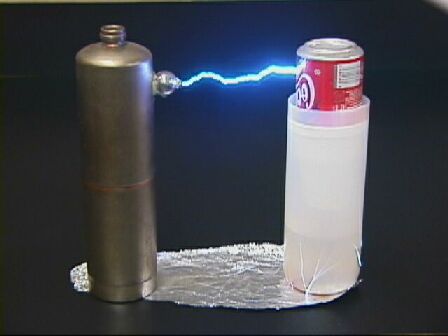 |
 |
|
|
Here is a way for anyone who wants to do experiments with
electrostatics and high voltage to do so without a Wimshurst machine or
Van de Graaff generator. The emphasis is on low cost, simplicity, and the
use of commonly available materials.
 |
 |
This device is charged with a 3 1/2 foot (1 meter) long piece of 1-inch (2.5cm) PVC pipe rubbed with a 1-foot (30 cm) long sleeve of the cheapest, roughest paper towel you can lay your hands on. I usually further wrap the bottom of the paper towel sleeve with a thick layer of cotton cloth to provide higher resistance so as not to bleed off too much of the charge to my hand, increasing the performance even more. The long sleeve is the key here. If you just grab a piece of cloth and rub the pipe, you get some nice little tingly sparks. But adding the sleeve increases the performance by at least a factor of ten. I believe the sleeve acts in a complex way to increase both the voltage and current. Its action is probably a combination of increased frictional area, induction, and capacitance. (Details)
I have measured voltage as high as 250kV with a short circuit current(to ground) of as high as 20µA on the forward stroke of the pipe through the sleeve. More typical measurements are about 150kV and 10µA-12µA. This compares very favorably with many Wimshurst machines and Van de Graaff generators. Of course, the disadvantage of this compared to an actual electrostatic machine is that the current and voltage are not continuous. Therefore, the the charging setup can't have any sharp points, or the charge will bleed off through corona leakage as fast as you charge it up. The soda can performs amazingly well as a Leyden jar electrode, as long as the sharp parts are buried inside the bottle. It will hold to about 150kV before it begins to hiss and spit.
These pictures were taken with a digital video camera under bright fluorescent light. The sparks are not quite as bright as they appear in the pictures, but they are nevertheless quite impressive to the uninitiated in electrostatics, not to mention being quite loud. These sparks are 5 1/2 inches (14cm) long, but under optimum conditions I have made sparks as long as seven inches (18cm). I think with a little tweaking of the configuration, they might be much longer. Incidentally, notice the small sparks snaking around the water level at the bottom of the bottle. The foil normally in place around the water level was removed to make the sparks dim enough to photograph. The sparks at the bottom of the bottle are probably due to the high degree of ionization of the plastic surface and surrounding air opposite the salt water.